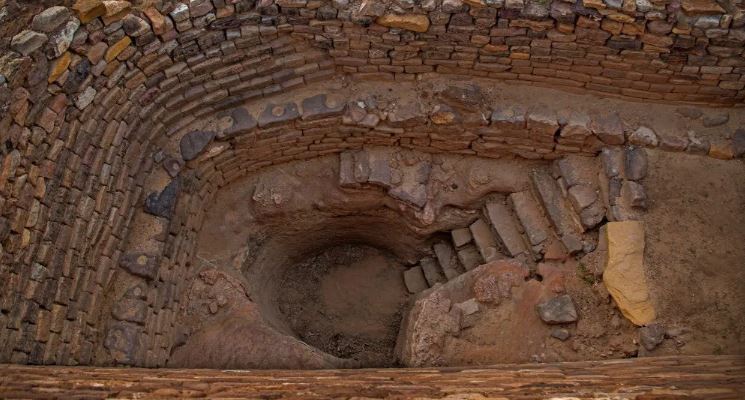Note4Students
From UPSC perspective, the following things are important :
Prelims level: Dholavira
Mains level: Indus Valley Civilization

The Harappan city of Dholavira, in present-day Gujarat, has been named the 40th Indian site on UNESCO’s World Heritage list.
Dholavira site
- The IVC acropolis is located on a hillock near present-day Dholavira village in Kutch district, from which it gets its name.
- It was discovered in 1968 by archaeologist Jagat Pati Joshi.
- The site’s excavation between 1990 and 2005 under the supervision of archaeologist Ravindra Singh Bisht uncovered the ancient commercial city.
Key features
- It is one of the very few well preserved urban settlements in South Asia dating from the 3rd to mid-2nd millennium BCE.
- It was located in the island of Khadir which was strategic to harness different mineral and raw material sources (copper, shell, agate-carnelian, steatite, lead, banded limestone, among others).
- It facilitated internal as well as external trade to the Magan (modern Oman peninsula) and Mesopotamian regions.
- One finds the origin of the Buddhist Stupas in memorials in Dholavira.
A gem in the IVC acropolis
- After Mohen-jo-Daro, Ganweriwala and Harappa in Pakistan and Rakhigarhi in Haryana of India, Dholavira is the fifth largest metropolis of IVC.
- The site has a fortified citadel, a middle town and a lower town with walls made of sandstone or limestone instead of mud bricks in many other Harappan sites.
- While unlike graves at other IVC sites, no mortal remains of humans have been discovered at Dholavira.
Its architecture
- The city demonstrates its multifaceted achievements in terms of urban planning, construction techniques, water management, social governance and development, art, manufacturing, trading, and belief system.
- The property comprises two parts:
- A walled city: Consists of a fortified Castle with attached fortified Bailey and Ceremonial Ground, and a fortified Middle Town and a Lower Town
- A cemetery to the west of the city
Trade and commercial activities
- Remains of a copper smelter indicate of Harappans, who lived in Dholavira, knew metallurgy.
- It is believed that traders of Dholavira used to source copper ore from present-day Rajasthan and Oman and UAE and export finished products.
- It was also a hub of manufacturing jewellery made of shells and semi-precious stones, like agate and used to export timber.
- Such beads peculiar to the Harappan workmanship have been found in the royal graves of Mesopotamia, indicating Dholavira used to trade with the Mesopotamians.
Famous for water conservation

- The expansive water management system designed to store every drop of water available shows the ingenuity of the people to survive against the rapid geo-climatic transformations.
- Water diverted from seasonal streams, scanty precipitation and available ground was sourced, stored, in large stone-cut reservoirs which are extant along the eastern and southern fortification.
- To further access water, few rock-cut wells, which date as one of the oldest examples, are evident in different parts of the city, the most impressive one being located in the citadel.
- Such elaborate water conservation methods of Dholavira is unique and measures as one of the most efficient systems of the ancient world.
Causes for its decline
- Harappans, who were maritime people, lost a huge market, affecting the local mining, manufacturing, marketing and export businesses once Mesopotamia fell.
- From 2000 BC, Dholavira entered a phase of severe aridity due to climate change and rivers like Saraswati drying up.
- Because of a drought-like situation, people started migrating toward the Ganges valley or towards south Gujarat and further beyond in Maharashtra.
- In those times the Great Rann of Kutch, which surrounds the Khadir island on which Dholavira is located, used to be navigable, but the sea receded gradually and the Rann became a mudflat.
Other Harappan sites in Gujarat
- Before Dholavira was excavated, Lothal, in Saragwala village on the bank of Sabarmati in Dholka taluka of Ahmedabad district, was the most prominent site of IVC in Gujarat.
- It was excavated between 1955 and 1960 and was discovered to be an important port city of the ancient civilisation, with structures made of mud bricks.
- From a graveyard in Lothal, 21 human skeletons were found. Foundries for making copperware were also discovered. Ornaments made of semi-precious stones, gold etc. were also found from the site.
- Besides Lothal, Rangpur on the bank of Bhadar river in Surendranagar district was the first Harappan site in the state to be excavated.
- Rojdi in Rajkot district, Prabhas near Veraval in Gir Somnath district, Lakhabaval in Jamnagar, and Deshalpar in Bhuj taluka of Kutch are among other Harappan sites in the state.
Answer this PYQ in the comment box:
Q.Which one of the following is not a Harappan site? (CSP 2019)
(a) Chanhudaro
(b) Kot Diji
(c) Sohgaura
(d) Desalpur
Also read:
Telangana’s Rudreswara Temple inscribed as a World Heritage Site
Get an IAS/IPS ranker as your 1: 1 personal mentor for UPSC 2024
